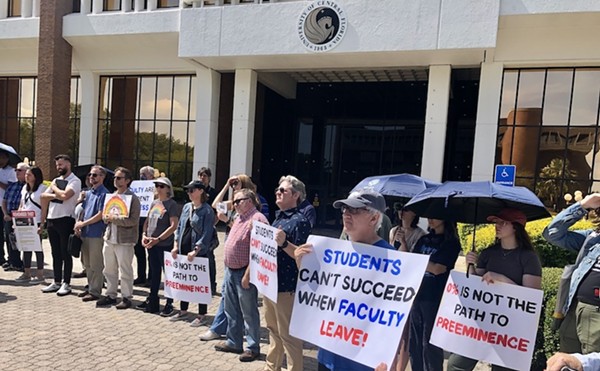Hercules Kohler rushes through his phone interview with a reporter. It's 11:15 a.m., and his 15-hour workday begins in just a few moments. He's bound for Sea World, where as a ride operator he'll pull in a little more than $6 an hour, he says. Then it's off to the Orlando/Orange County Convention Center, where the full-time set-up worker will make $7.73 an hour as a county employee. All totaled, he works about 90 hours a week.
It's a familiar pattern, not just for the 25-year-old Micronesian immigrant, but for countless thousands in this tourism-driven economy struggling to put food on the table. Sure, Kohler -- who completed two years of carpentry training at the College of Micronesia -- would like to spend more time with his six-month-old baby. But that's not possible right now.
"The money [the county has] been paying [me]," he says through a slight accent, "is nothing. If they paid me enough, one job is enough.' Even if he sticks with his convention center job for a few more years, he'll hit a top wage of $10.81 an hour. With that in mind, he's looking for an opening with the county in a more open-ended trade, maybe as an electrician.
Right now though, he's late for work and has to run.
Kohler's county pay, which adds up to just over $16,000 annually, falls about $1,000 short of what the federal government considers a "living wage" -- $17,650 a year, or about $8.48 an hour, the bare minimum the government calculates is required for a single breadwinner to keep a family of four going.
Until last month, Larry Snell, a 37-year-old who worked in the county's roads and drainage department for more than a year, took home even less: $7.22 an hour, which he earned for mowing lawns and flagging traffic for sidewalk repair in the hot Florida sun. But Snell, apparently, had had enough, as his resignation letter indicates.
"I am truly sorry for having to leave Orange County," read his letter, which was scrawled in black marker. "I am having money problems that overwhelm [sic]. I had to take a job that pays more." Because of its low pay, Orange lost a worker who was, according to his personnel file, experienced and who scored higher on his application than his counterparts.
Kohler and Snell aren't alone. Of Orange County's 5,789 full-time employees, 118, or 2 percent, earn less than living wages. According to one estimate, 26 percent of Central Florida workers employed by companies with government contracts earn less than $8.73 an hour, another living-wage number often used by labor groups. Still, that's a far sight better than the private sector, where 42 percent of the region's workers make less than $10 an hour, according to the Orlando Regional Chamber of Commerce.
Labor groups feel it sets a poor example for local governments to be, in essence, subsidizing poverty.
Actually, says AFL-CIO district councilman Steve Hall, a living-wage may save money in the long run. "It's pay me now [or] pay me later," he says. "Pay me later seems more expensive." The less money workers make, he contends, the more they rely on public-assistance programs.
In fact, the living-wage tide is rising. More than 50 municipalities, from tiny townships to some of the country's biggest cities, have enacted living-wage ordinances, which not only give raises for low-end government employees but also force private companies that receive subsidies from or contracts with the government to pay all their workers above-poverty wages.
The area's newly formed Living Wage Coalition wants to push Central Florida onto the bandwagon. In coming months, the grass-roots group of labor representatives, social-justice activists and students will launch a campaign aimed at pressuring local governments to make sure all of their workers receive at least living wages.
But even if they're successful, a living-wage law won't directly affect Disney -- which pays full-time workers as little as $6.70 an hour -- or any other employers in the tourism industry that is notorious for underpaying its workforce, many of whom work two jobs just to keep a roof over their heads. Still, says College of William and Mary economics professor and living-wage advocate William Rodgers, such an ordinance sets a good example for local businesses.
"[Living wage] raises the question of what is society's value," Rodgers says. "Do we really value the work that lower-wage workers do?"
The living-wage movement is a relatively new phenomenon, born out of activists' frustration with the $5.15-an-hour federal minimum wage, which has been stagnant since 1997. Though two living-wage-type laws predate it, the current movement caught steam following the Newt-Gingrich-led Republican takeover of the U.S. House of Representatives in1994, as proposals to raise the minimum wage died in Congress while the inequity between white-collar workers and blue-collar workers skyrocketed, with corporate execs' pay soaring while their employees' did not.
Despite quasi-living wage laws in Des Moines (1988) and Gary, Ind., (1991), labor groups hail Baltimore's ordinance, passed in 1994, as the watershed. It required city contractors to meet wage requirements -- then $6.10 an hour, and since adjusted upward for inflation. From there, the living-wage movement quickly spread to California while simultaneously shooting up the northeast coast to New York City and west to St. Paul.
Only two Florida municipalities have living-wage ordinances: Miami-Dade County, which adopted its ordinance in May 1999, and more recently, Miami Beach, where a living-wage law was approved this past April. Last month, Gainesville and Alachua County each endorsed living-wage legislation, asking their managers to develop a plan to bring all city employees up to living wages (the exact figure will lie between $7.48 and $9.48 an hour, though the middle number, $8.48, is expected).
The living-wage campaign in Gainesville took a full 18 months, with community activists lobbying local leaders and educating their constituents on the positive effects a living-wage law would have. But even with the recent vote, and the plan for a law to be implemented by October, labor groups didn't get a complete win.
Indeed, says Alachua County Commissioner Robert Hutchinson, the city and county bowed to business groups and stopped short of requiring government contractors to pay living wages as well, making it different from most other living-wage laws. That's not to say, however, that the country's other laws are the identical. Often, they're as different as the places that enact them.
The living-wage figure itself can be as small as $6.25 an hour, in Milwaukee, or as high as $12 an hour, in Santa Cruz, Calif. (Typically, the number hovers between $8.50 and $9.50). Most -- but not Gainesville or Alachua County -- require government contractors to pay both living wages and health insurance.
According to the U.S. Department of Health and Human Services, the "poverty line" for a family of four is $17,650; for a family of three, it's $14,630. In terms of hourly pay, if the sole breadwinner in the family of four earns $8.50 an hour, he or she must work year-round, 40 hours a week, to hit that mark. If he or she gets two unpaid weeks off, the hourly minimum goes to $8.83 an hour. To provide for a family of three, one must earn at least $7.03 an hour -- again, 40 hours a week, 52 weeks a year -- to make do.
Every local government that returned Orlando Weekly's request for information has workers earning below living wage. Beyond Orange County's 118, Seminole County has 46, the Orange County School Board has 396, and so on. The city of Orlando had 22 -- at least, until the Orlando City Council approved across-the-board raises for 1,400 of the city's 3,237 workers this week.
A few months ago, the city hired Palmer & Cay, a Jacksonville-based consulting group, to compare its pay rates with other, similar-sized municipalities. Its analysis found that Orlando paid its workers up to 10 percent less than the market average. The just-approved recommendations raised the city's floor wages from $7.61 an hour to $9.31 an hour.
Still, as Mayor Glenda Hood's spokeswoman Susan Blexrud puts it, "We don't call it 'living wage.'" The increase in the city's minimum wage is just a byproduct of the larger, $1.7 million adjustment aimed at keeping Orlando competitive both with other governments and the private sector. That, and not the living wage, was the most pressing concern, she said. After all, the city's contractors and subsidy-recipients are free to pay their workers whatever they want.
Much of the local living-wage campaign's research has focused on Orange County employees. Among local governments, Orange has the second-biggest budget (behind Orange County Public Schools) and most influential bully pulpit. A living-wage ordinance for Orange County would be a huge victory for advocates.
Bringing all of Orange's workers up to $8.48 an hour would only cost the county about $84,000 a year, according to an Orlando Weekly analysis, a small part of the more than $2-billion budget. Given that figure, commissioners seemed receptive, if a bit cautious.
"I'm not sure about the mechanics [of a living-wage ordinance]," says Commissioner Bob Sindler, "[but] it certainly bears looking into."
To activists, bringing local governments' many temporary workers and employees of government contractors into the living-wage fold is a more pressing -- and indeed, more controversial -- goal.
Orange employs 1,115 temp workers. Most are part-time, and the vast majority make less than $8.73 an hour, according to data compiled by Rollins College professor and living-wage researcher Eric Shutz. On average, those workers earn about $7.21 an hour. Orlando has 561 seasonal and temp employees earning less than $8.48 an hour. Those numbers have both elected officials and labor groups worried that governments are streamlining expenses by hiring part-timers and not paying them either full-time benefits or living wages.
The city, says labor representative Rich Lyons, is taking people from temp agencies and shifting them around to fill more than 200 vacant full-time positions. And until a labor union's recent protest, he says, the city didn't force the temps through the rigmarole of the full-timers, including drug testing.
The county, according to Commissioner Mary Johnson, has many temp workers "that have been here for years," she says. "I was wondering why they haven't been made [permanent]." She recently asked county staff to look into the matter.
About 500 companies regularly contract with Orange County for a myriad of jobs, such as landscaping, construction, janitorial services and security. These, Shutz estimates, employ about 1,133 people who work almost solely on government projects, sort of de facto county workers.
Of those, he says, using data culled from the 2000 U.S. Census and the U.S. Department of Labor, 293 earn less than $8.73 an hour and 561 earn less than $10.48 an hour. For the first group, he adds, an average wage is about $5.92 an hour; for the second, it's $6.89 an hour.
The controversial kicker: Bringing these workers up to living wages, Shutz says, would cost between $1.6 million and $2.9 million a year, depending which standard you use. In Gainesville's living-wage debate, that's where the advocates lost.
But if Alachua County did require its contractors to pay the higher wages, Hutchinson says, the impact on the private sector would be greater. "If everyone else is getting a living wage," he says, "it's kind of hard to hire [lower-paid] workers."
The main problem, he says, was monitoring. Though it's unlikely the higher wages would produce more costly government-work contracts -- bid prices in Baltimore actually decreased after the ordinance passed, according to a 1999 study -- Hutchinson says it would cost about $500,000 a year to monitor contractors.
A better way, he suggests, is to have county staff ask its bidding contractors to provide information on "performance standards," such as employee turnover. Such a factor would indicate whether or not the contractor is paying his or her employees well -- "a surrogate for the living wage," says Hutchinson.
Shutz, however, counters that Gainesville and Alachua County are the exception, not the rule; nearly all living-wage ordinances apply to contractors. And even with Miami-Dade's monitoring costs, taxpayers still come out on top through decreased government aid and the increased buying power of the poor, according to an evaluation by Florida International University professor Bruce Nissen.
The first problem with starting a living-wage campaign, naturally, is money. The grants the local living-wage coalition have received to date, mostly from the National Inter-faith Committee for Worker Justice, might not be enough to fund the full-court press they plan to bring later this year. Second, they're still trying to organize, to figure out who among the hundreds of names on their lists actually will help and who was merely curious.
The coalition, says labor leader Debra Booth, branches off from the Central Florida Interfaith Council for Worker Justice and Dignity, a hodgepodge of social groups such as Catholic Charities, labor unions and academics. It formed earlier this year, following a December conference in which Nissen outlined how the South Florida coalition pushed through its living-wage law despite business groups' objections.
The key: timing. In fact, members of the group debated whether cooperating with a reporter at this juncture was appropriate, for fear they may spark a public debate before their research is complete. In Miami-Dade, Shutz says, the living-wage coalition had well-timed press releases and media ops that got the issue needed print.
And, they know, Central Florida isn't as liberal as other areas where such efforts have been embraced. It's notoriously conservative, a place where a school board now more than $1 billion behind in school construction is scared to bring a vote on a half-cent sales tax. Coalition members know their campaign here will be a tough sell. As a result, they are placing their hopes on a series of small victories -- an evolving living-wage law -- rather than a California-esque home run.
But, as Alachua's Hutchinson says, activists tend to be much more organized than their opponents. And the argument is tough to refute without looking like a bad guy. "Who," he asks, "can say no, you shouldn't have a living wage?"
Even Ax the Tax leader Doug Guetzloe, who has continually rallied against increased government spending, speaks somewhat favorably of the concept. "The concern I would have is how to achieve [worker] equity without busting the budget," says the high-profile rabble-rouser and AM talk-show host. "Of course you want to be fair and provide a living wage, but there has to be some consideration that these are our tax dollars."
The campaign is not so focused on the government itself; rather, it wants the city and county to send a message. And while not exactly offering her endorsement, Orange County Commissioner Teresa Jacobs recognizes that the county's "leadership role" in advancing a living-wage law could have "some merit to it."
The big question, however, is how such an ordinance would impact the private sector. After all, were Orange County to pass the law, only about 400 people would be directly affected.
"The more people who are doing the right thing," says AFL-CIO community liaison Jennifer Kenny, a member of the living-wage coalition, "the more people will fall in. It's a social consciousness thing." As the campaign exposes the fact that full-time workers still are scraping to get by, she hopes, community pressure will force changes.
But what about Disney, the area's biggest employer, whose name is a four-letter word in some labor circles? Recently, the Mouse's largest union reluctantly approved a three-year contract that included a 22-cent raise for long-time veterans and a slight increase in minimum pay. Still, the top rate, regardless of how long an hourly employee has worked for the company, is just $11.12 an hour.
Neither Disney nor its competitors would be affected at all. As John Koenig, head of the nonprofit Orlando Regional Workforce Development Partnership, points out, most of the service sector probably wouldn't care one way or the other.
"The government-contracting route certainly sends a message," says Koenig, a former Orlando Sentinel business columnist, "but it doesn't have a widespread effect. The reality is, that's driven by the economics of business."
In other words, he says the service industry would ignore government's leadership -- and, he argues, that may not be a bad thing. If the fast-food industry, for instance, paid $10 an hour to its employees, the price of a hamburger would go up. On a macro scale, if all low-paid workers got raises, the increased cost of goods, Koenig says, would negate any gains they made.
And if a county wants to successfully implement a living wage, he continues, it must be prepared to pay its contractors more -- if there's no profit to be made, companies won't do the work. Although that doesn't appear to be the case in Baltimore, the only city whose ordinance old enough to offer a track record.
But perhaps the most important thing a successful living-wage campaign could do -- especially for Central Florida -- is bring more attention to the thousands of low-paid, 80-hour-a-week workers trying their best to put food on the table. It could make them seem human, not just as floor-scrubbers or waiters. Indeed, the debate in Gainesville produced a change in the community's mindset.
During that discussion, a retiring county manager observed to Commissioner Hutchinson that the world had flipped upside-down. Three years ago, the public had commended the manager for reducing janitorial costs, which he achieved by awarding contracts to companies that paid their workers at or just above the minimum wage. Today, the community was telling him that was wrong, that cost-cutting wasn't as important as ensuring quality of life.
"[Government is] the backstop for people's lives," says Hutchinson. "We end up dealing with those problems [associated with poverty]. It's all connected."

















